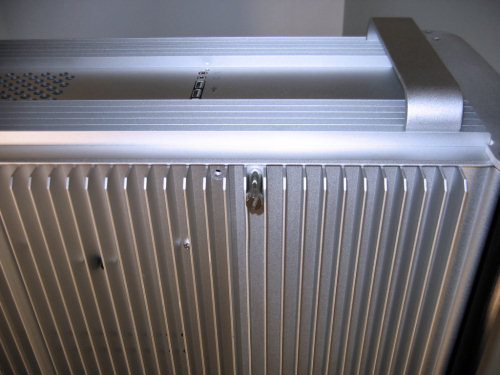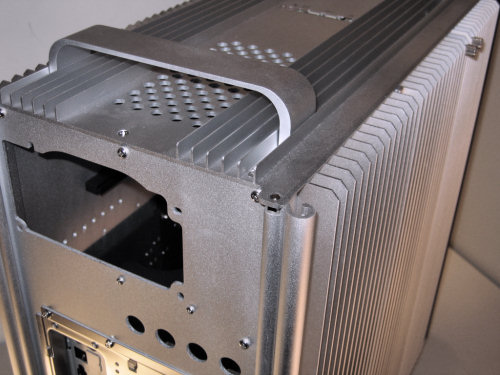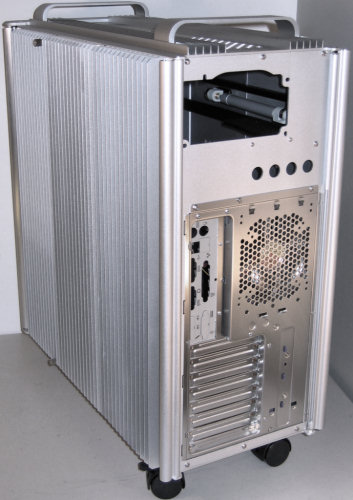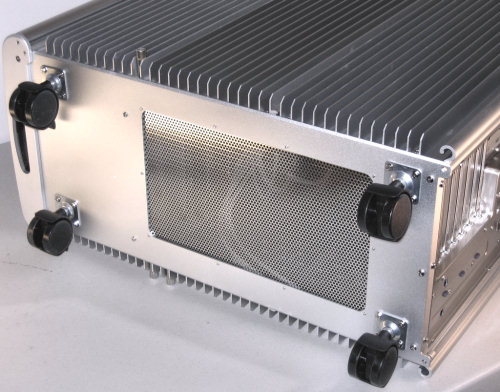Clash of the Titans - TT Tai Chi vs. CM Stacker 830
by Joshua Buss on February 23, 2006 12:05 AM EST- Posted in
- Cases/Cooling/PSUs
Thermaltake Tai Chi (cont’d)
An inch and a half long extended thumbscrews hold each part of the hinged door at the top and bottom, and since it's a double-hinge design on the left side, a total of four thumbscrews can be used – however, the front flap overlaps the main door and thus a single screw on the front panel at the top or bottom is the minimum needed to hold the side shut.
Moving further backwards, we can take a close look at the rear handle and rear backing plate. The thickness of the aluminum panels is very evident in this picture, as is the fact that the case can be completely separated into component parts and screws.
At first, this feature might seem rather unimportant, but the more that one thinks about it, the more obvious it is that to the enthusiast and even casual modder, this component nature is exceptionally valuable. For instance, the default ports visible in the back plate here for water cooling are 3/8” in diameter, which is fine for 3/8” O/D water tubing. However, 3/8” ID (inner diameter) tubing is pretty popular too, and without the ability to remove this plate from the rest of the case precisely enlarging these holes to the proper size would be much more difficult.
The over-sized rounded edges on the back resemble the look of the corners at the front of the case, but more importantly, they simply provide protection from the rest of the back of the computer and the rear-most fins of the side panels. Notice also how the rear of the case and the back of the motherboard area are completely separate, so that with a different motherboard standard such as BTX, all one needs to do is replace this back plate.
Turning the case on its side to inspect the bottom reveals that just as much attention to detail has been paid to it as the rest of the case. First off, notice that the heavy-duty casters are removable, should one decide they really would have the case take up less vertical space or simply have replacements that they'd rather use instead. When raised, however, the case benefits from the additional airflow capabilities of the hole in the front area and large perforated steel section. With the default casters left in place, a standard 120mm case fan can actually mount directly to this mesh from the bottom and still have enough clearance underneath it to function well.
Before opening the case, we really felt that this case deserved an extreme close-up to show off the immaculate finish and heavy thickness of the aluminum used.
The Tai Chi is really almost an entirely new kind of case, and the construction and sheer quality of materials used are some of the easiest ways to really see what we mean by this. In this photo, notice for instance how nice the contrast between the brushed finish of the front doors and the brilliant finish of the rest of the case look. Aesthetically, there simply isn't any other case to which to compare the Tai Chi – its marriage of passive radiation with other functionality-driven design choices gives it a unique, stately, and downright intimidating style that really requires seeing it in person to appreciate.
An inch and a half long extended thumbscrews hold each part of the hinged door at the top and bottom, and since it's a double-hinge design on the left side, a total of four thumbscrews can be used – however, the front flap overlaps the main door and thus a single screw on the front panel at the top or bottom is the minimum needed to hold the side shut.
Moving further backwards, we can take a close look at the rear handle and rear backing plate. The thickness of the aluminum panels is very evident in this picture, as is the fact that the case can be completely separated into component parts and screws.
At first, this feature might seem rather unimportant, but the more that one thinks about it, the more obvious it is that to the enthusiast and even casual modder, this component nature is exceptionally valuable. For instance, the default ports visible in the back plate here for water cooling are 3/8” in diameter, which is fine for 3/8” O/D water tubing. However, 3/8” ID (inner diameter) tubing is pretty popular too, and without the ability to remove this plate from the rest of the case precisely enlarging these holes to the proper size would be much more difficult.
The over-sized rounded edges on the back resemble the look of the corners at the front of the case, but more importantly, they simply provide protection from the rest of the back of the computer and the rear-most fins of the side panels. Notice also how the rear of the case and the back of the motherboard area are completely separate, so that with a different motherboard standard such as BTX, all one needs to do is replace this back plate.
Turning the case on its side to inspect the bottom reveals that just as much attention to detail has been paid to it as the rest of the case. First off, notice that the heavy-duty casters are removable, should one decide they really would have the case take up less vertical space or simply have replacements that they'd rather use instead. When raised, however, the case benefits from the additional airflow capabilities of the hole in the front area and large perforated steel section. With the default casters left in place, a standard 120mm case fan can actually mount directly to this mesh from the bottom and still have enough clearance underneath it to function well.
Before opening the case, we really felt that this case deserved an extreme close-up to show off the immaculate finish and heavy thickness of the aluminum used.
The Tai Chi is really almost an entirely new kind of case, and the construction and sheer quality of materials used are some of the easiest ways to really see what we mean by this. In this photo, notice for instance how nice the contrast between the brushed finish of the front doors and the brilliant finish of the rest of the case look. Aesthetically, there simply isn't any other case to which to compare the Tai Chi – its marriage of passive radiation with other functionality-driven design choices gives it a unique, stately, and downright intimidating style that really requires seeing it in person to appreciate.















55 Comments
View All Comments
Tamale - Friday, February 24, 2006 - link
I made the most prominent mention of it right before the sound chart:"With the finding that the Tai Chi cools just as well as the Stacker 830 with half as many fans, one has to wonder if that means that the Thermaltake fans are making substantially more noise. To see if that's the case, we used our sound pressure level (SPL) meter and rated the system's noise subjectively on a scale from 1 to 10."
Even without taking the fans into consideration, the two cases' temperatures were very, very close. Look at the HTPC roundup to see how much they've different in the past.
JoshuaBuss - Friday, February 24, 2006 - link
1) It's ok for different people to have different definitions of 'high-end'. For me, a great case for a decent price is higher-end than a case that costs twice as much and doesn't offer as much.2) I mention the passive radiative design of the Tai Chi as a benefit, but perhaps didn't stress enough that the design is for the most part a waste unless one attaches additional cooling equipment to the sides so that conduction of heat to the fins would actually take place. What is true is that the case cools exceptionally well with only two fans. Is it the fins helping? While certainly I agree with you that they're not helping that much, I would still say that they're helping a little.
3) The cage itself lacks any active defense against vibrations unfortunately. Its design is of thinner material that has more bends to it, so inherantely it will aborb a little bit of the vibrations, but not much. We really preferred CM's cage in this regard, for this and the 4 drive capacity. That being said, seagate barracuda drives are still very, very quiet in the Tai Chi.
fsardis - Friday, February 24, 2006 - link
making the case out of alu does help dissipate heat from inside. the hot air does make the alu hotter and the fins increase the contact area with the ambient air.the only proper argument against the heat sink design is that although it has fins to dissipate heat outside, it doesnt have a large contact area inside so the hot air of the interior wont transfer heat to the alu as fast. then again all this applies only in cases of passive cooling. with active cooling the whole heatsink design is wasted since the hot air gets thrown out and fresh air comes in.
i am the owner of a stacker 830 and i am disapointed to say the least. there is not a single spot in the case to mount even a single water cooling rad. having read so many reviews on the net about how this case is good for water cooling, i seriously question the validity of other reviewers and not of the anandtech reviewer.
ATWindsor - Friday, February 24, 2006 - link
I doubt the difrence between fins and no fins when the side only has contact with air is within uncertanties int he measurments, i see it as little more than a gimmick. And aluminum in itself also have little improvment in heat (over steel).LoneWolf15 - Thursday, February 23, 2006 - link
can be a pain already, but the dual-doors like on the Tai Chi are worse than a single one, IMO. It can make it really hard to put a case under a desk, or in a small area, and I would get really tired of having to open two doors every time I wanted access to one of my drives (which is why I got an Antec P-160, which stealths the optical/floppy drives quite nicely without needing doors).I like the CoolerMaster's design. Still not a fan of a door on a case, but it seems cleaner than Thermaltake, whose cases have always come off as somewhat gimmicky to me.
Good review, guys.
JoshuaBuss - Thursday, February 23, 2006 - link
The dual-doors aren't really as bad as you'd might think, but yes, it will definitely be a problem unless you have a large open space to the left of the tower... that is of course only if you care about opening it at all.. hehkalaap - Thursday, February 23, 2006 - link
I don't think this case is made for small spaces.latino666 - Thursday, February 23, 2006 - link
Uhh I can't see the pictures anyone know reason why?Also I did use Firefox and IE
ATWindsor - Thursday, February 23, 2006 - link
For some odd reason i don't get up pictures on anand anymore if i disable referer-logging, could that be the case for you?TallCoolOne - Thursday, February 23, 2006 - link
I also cannot see the pics, and also tried both Firefox and IE.